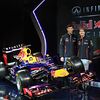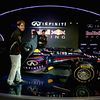Red Bull RB9 launch - technical analysis
Red Bull's RB9 is a clear evolution of the championship winning RB8, but then again, so were the RB7 and the RB6, who also won both championships driven by Sebastian Vettel. This time around, we can again expect something special on the Newey designed racer.
One of the most remarkable features at first sight is retaining the stepped nose. The chassis itself and hence the front bulkhead is as high as it can be within the regulations, so a vanity panel on top of the nose cone is used to smooth the step that is created. However, it's just a very small panel, creating some sort of a ramp, after which Red Bull have seemingly hidden a tiny air outlet, most likely a copy of Sauber's S-duct that catches high pressure air from underneath the nose and spits it out on top of it, creating a tiny bit of downforce.
The front wing on the launched car is clearly a place holder and will undoubtedly change during testing. Newey however said much work went into the design of the new front wings for this year, as the FIA beefed up its flexing test to further reduce the team's possibilities to exploit flexibility and twist under high speeds.
The sidepods at the front have changed only little, with Red Bull retaining the same philosophy of implementing a big, short sidepod of which the upper surface drops down rapidly towards the rear end of the car. The car's design around the cockpit appears to be very similar to what was present on the RB8 as well, with seemingly identical crash protection structure left and right on the cockpit opening. Also the mirrors are nothing special, although Red Bull have minimised the length of the support to reduce yet again another tiny bit of drag.
Suspension wise, the team slightly redesigned the suspension elements to allow for a wider window of settings to be able to better exploit the Pirelli tyres. This appears to be a major trend among all teams. Heavily focusing on this, Red Bull have retained their traditional push rod front suspension and the rear end pull rod suspension.
Particularly interesting is yet again the rear end of the car. While the exhaust area is likely to change early on in testing, a way for the team to give away too much at the launch, some changes are remarkable. One of these is the swan neck on the beam wing, which denotes a different style of connection of the beam wing to the chassis. While this is traditionally done by a single support underneath the wing (because that is the shortest connection possible), Red Bull have now used a connection that attached to the upper surface of the beam wing, cleaning up the area underneath the wing.
However, the most peculiar item of the car is a bulge in the floor just behind the exhaust outlet (which on its behalf also appeared to be a 2012 specification bodywork element). This bulge was notably absent on the renderings that Red Bull Racing released of its new car. It is surely also no coincidence that no pictures were revealed of the car's rear end, with the media present not allowed to take any pictures at all.

This bulge may be twofold and could be crucial for the car's rear end downforce generation, but could nonetheless already be seen on the RB8 in its Brazilian GP specification at the end of 2012. First of all, it has the potential to slightly redirect exhaust gases towards the area between the diffuser and the inner wall of the rear tyres. This happens to be the area most interesting to have exhaust flow, as it can work as a seal for the diffuser.
However, while it is totally unproven yet, it would be surprising if this is just a bulge, as the height of it is quite substantial, creating the possibility to have air flown within the bulge itself. It is speculation at this time, but it does not need a huge amount of imagination to see the possibility of air flowing within this bump and exiting just over the diffuser, possibly over the entire width of the diffuser. Where this air comes from is also still up for discussion, but this could both be from within the sidepod, as well as from the channel underneath the exhaust. Wait and see...







